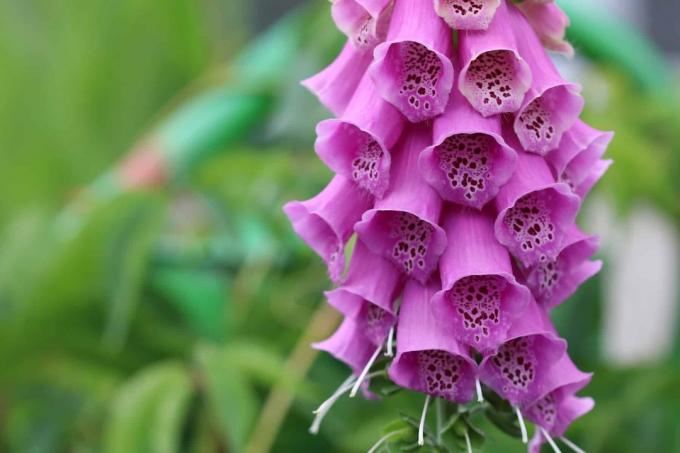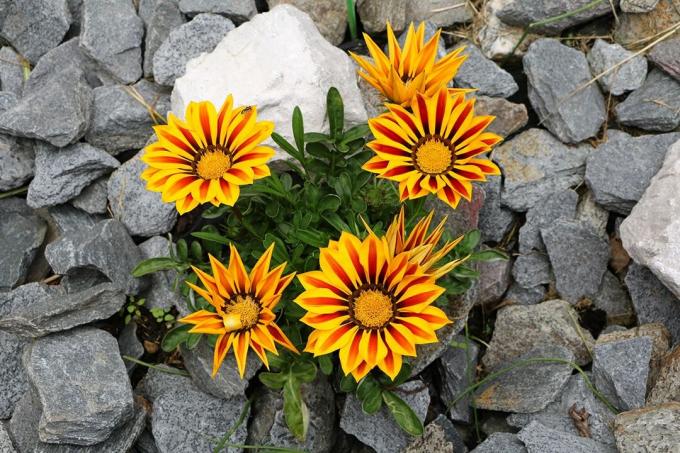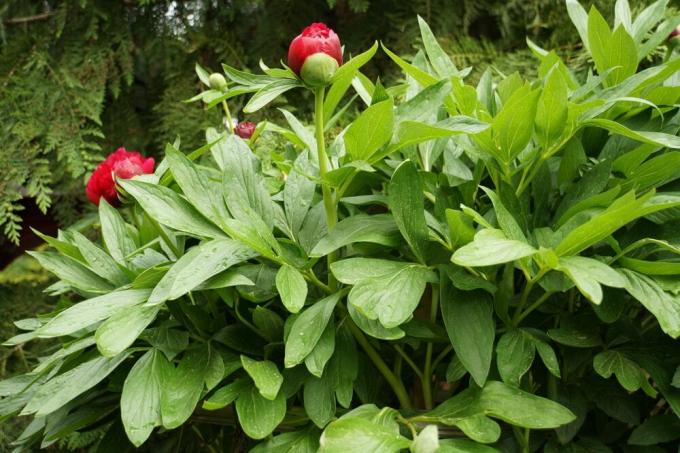

Table of contents
- Poisonous beauties in the garden
- Poisonous crops
- symptoms of poisoning
- First Aid Measures
- frequently asked Questions
- Worth knowing about poisonous flowers shortly
Mother Nature wakes up with the first warm rays of sunshine and sets the first colorful accents in the garden with her heralds of spring. However, if you share your garden with dogs, cats and the like, you should do without some plants. No matter how beautiful they may look, flowers and plants sometimes contain toxic substances that can lead to irritation and severe symptoms of poisoning. But which plants are dangerous and what to do to help your beloved four-legged friend immediately?
Poisonous beauties in the garden
Plants protect themselves from being eaten with unpleasant smells, a bitter taste or prickly thorns. But playfulness and curiosity often tempt animals to nibble on poisonous plants. Because they cannot distinguish what is good and what is bad. Many a houseplant is already a potential source of danger. Whether the parrot is pecking at the aloe vera or the cat is sharpening its claws on the rubber tree – toxic substances lurk in many beauties. Among other things in poisonous ornamental plants:
Adonis
- all plant parts
- contains toxic substances such as cardiac glycosides
- general symptoms of poisoning (see below) and cardiac arrhythmias possible
aloe vera
- especially leaves
- Ingested orally, the ingredient saponin causes irritation in the mouth and throat, as well as the digestive tract
- strong laxative effect
- irritation of the kidneys
- signs of paralysis and cramps
amaryllis
- Onions are poisonous
- Amaryllis plants such as snowdrops or knight's star are dangerous for dogs, cats, guinea pigs and hamsters
- Onions contain high doses of the toxin lycorine
- general signs of intoxication
azalea
- flower nectar and leaves
- initially cause a burning sensation in the mouth
- later there are general symptoms of poisoning, irregular heartbeat, muscle weakness and loss of vision
boxwood
- all plant parts
- contains various alkaloids
- general signs of intoxication
Christ thorn
- milky juice
- Contains ingenol esters that irritate skin and mucous membranes
- causes increased salivation and abdominal cramps
- visual disturbances are possible upon contact with the eyes
Christmas rose
- roots and seed pods
- contains toxic substances such as hellbrin, saponins and protoanemonins
- general signs of intoxication
yew
- Seeds and needles very poisonous
- contains different alkaloids
- general signs of intoxication
- Circulation collapses and breathing is paralyzed
angel trumpet
- all parts of the plant, especially roots and seeds, highly poisonous
- contains toxins such as atropine, hyoscyamine and scopolamine
- general signs of intoxication
- Shortness of breath through to circulatory and respiratory arrest
ivy
- stem, leaves and sap of the plant
- the bitter-tasting berries are highly poisonous
- not only domestic animals endangered, also grazing animals
- irritate mucosa
- general signs of intoxication
- Consumption often leads to death from cardiac arrest
thimble
- all plant parts
- contains high doses of toxic digitaloids
- lethal even in small amounts by cardiac arrest
- general signs of intoxication
- severe cardiac arrhythmias
broom
- Seeds and leaves are considered highly poisonous
- contains the toxic alkaloid sparteine
- Toxic to domestic and grazing animals
- general signs of intoxication
- constipation and intestinal obstruction are also possible
laburnum
- mature seeds
- contain different quinolizine alkaloids
- dogs usually vomit immediately
- general signs of intoxication
autumn crocus
- all parts of the plant highly toxic
- contains the main toxin colchicine
- initially stimulating and then paralyzing
- general symptoms of poisoning up to cardiovascular failure
hydrangea
- especially flowers poisonous - even after drying
- contains toxic ingredients such as saponins and hydrocyanic acid
- general signs of intoxication
hyacinth
- all parts of the plant
- contains calcium oxalates, which damage the lining of the mouth and throat
- general signs of intoxication
Cherry and ornamental laurel
- especially seeds and leaves
- Flesh almost non-toxic
- contains glycosides as a plant toxin
- general signs of intoxication
- strong poisoning causes respiratory paralysis
crocus
- Tuber and stalks of stigma dangerous to domestic and grazing animals
- contains the toxic substance picrococin, which is broken down into safranal.
- can be fatal to rabbits
- general signs of intoxication
lily of the valley
- all parts, especially fruits and flowers
- contain glycosides
- general signs of intoxication
- Cardiac arrhythmias and, in the worst case, cardiac arrest
oleander
- all plant parts
- contains toxic glycosides nerioside and oleandrin
- there is irritation in the stomach and intestines, restlessness
- Heart rate drops, heart failure possible
euonymus
- all plant parts
- seeds in particular contain steroid glycosides
- general signs of intoxication
snowdrop
- the onion is poisonous
- contains different alkaloids
- general signs of intoxication
deadly nightshade
- especially the berries
- toxic ingredients are hyoscyamine, belladonnin, apoatropine, scopoletin and scopolamine
- Poisoning is shown by aggressiveness, dilated pupils, increased thirst, restlessness, tachycardia
- shortness of breath and respiratory paralysis are also possible
tulips
- every part of the plant
- contains tuliposides, which irritate mucous membranes
- general signs of intoxication
Poisonous crops
Not only ornamental plants, but also some useful plants are dangerous for our beloved four-legged friends. The toxic effects of various useful plants can sometimes be life-threatening for cats, dogs and the like. The best known among them are:
avocado
- The flesh and stone are toxic to grazing animals and pets
- contains the deadly toxic substance persin
- Poisoning leads to death
- not treatable
wild garlic and garlic
- easily confused with the leaves of the autumn crocus
- particularly toxic to rodents and horses
- contain the toxic alliin
- general signs of intoxication
- Circulatory disorders, circulatory problems
beans
- contains toxalbumins (poisonous protein compounds)
- Main active ingredient phasin
- particularly dangerous for rodents and grazing animals, as well as pigs
- general signs of intoxication
potato plant
- aboveground plant parts
- Herb contains the toxic substance solanine
- this also increases in green and sprouting potatoes
- general signs of intoxication
- sometimes the red blood cells break down
tomato plants
- Tomato herbs and unripe fruits contain solanine and atropine
- cause not only general symptoms of poisoning but also inflammation of the mucous membranes in animals
walnut
- the fruit skins are poisonous
- the fungus they contain acts like a neurotoxin
- leads to instant death
onions
- Toxic in any form to dogs and cats
- Ingredients destroy red blood cells, which can lead to anemia
Tip:
Irrigation water is particularly attractive for the beloved four-legged friends. If this is supplemented with fertilizer, dogs and cats should be kept away when watering the garden plants.
symptoms of poisoning
If poisonous plant parts have been ingested by the beloved pets, owners can recognize this by the following signs:
- increased salivation
- Vomit
- Diarrhea
- painful abdominal cramps
- uncontrolled body control such as shaking or staggering
- difficult breathing
- declining sympathy to the point of lethargy
- Dilation or narrowing of the pupils
First Aid Measures
Despite all caution, it can happen again and again that dogs, cats and the like dig up flower bulbs or nibble on poisonous parts of plants. Here's what the first aid looks like:
- Remove residue from mouth and rinse thoroughly with water
- Rinse body parts that have come into contact with poisonous plant parts
- observe animal
- if the above-mentioned symptoms of poisoning appear, the veterinarian should be informed and consulted
- if there are leftovers, take them with you to identify the plant
frequently asked Questions
Grapes, both fresh and dried, are harmful to pets. The oxalic acid it contains can lead to acute kidney failure.
The pits of all types of stone fruit should be taboo for dogs and cats. They contain toxins from which hydrocyanic acid splits off in the animal's organism and cell division is blocked. The result is typical symptoms of poisoning, which can lead to death.
Worth knowing about poisonous flowers shortly
Quite a few "poisonous beauties" are at home in our local flower pots and gardens. Many of them are even extremely popular. Some of the most well-known poison flowers in our gardens and living rooms are:
- the lily of the valley,
- the snowdrop,
- the delphinium,
- the thimble,
- the laburnum,
- oleander,
- the autumn crocus,
- the cup primrose
- and the belladonna lily.
The poisonous flowers in our home or garden pose the greatest danger to small children. After all, they are always tempted to put everything in their mouths or try it. And most poisonous flowers happen to be enticingly colorful and emit a pleasant scent. That's why it's important to pay close attention, especially with small children, to which flower they pick from the meadow! But even many adults rarely know exactly which plants are poisonous and what the poison of a plant can do.
Example: Laburnum
Laburnum, for example, is a beautiful shrub that will brighten up any garden with its bright yellow flowers. But as beautiful as the laburnum is, it is also dangerous. The seeds of this shrub, when ripe, are reminiscent of beans in shape. And it is precisely this part of the plant that is the most poisonous. Even small amounts of the substance contained can cause nausea, vomiting and tremors. There are even cases where ingesting parts of the plant has resulted in death. In these cases, respiratory paralysis or total circulatory failure occurred.
Example: thimble
Another beautiful yet poisonous inhabitant of our gardens is the foxglove. And most people know that the foxglove is poisonous. But how toxic exactly, few people know. There are of course different types of thimbles. They differ in the shape of the flowers, stems and leaves. However, all foxglove species have one thing in common: they are all highly toxic. Even small amounts of the foxglove poison can lead to nausea and vomiting. This condition can last for several days. Even worse, however, are the consequences that the poison has on the heart and circulatory system. The heart rate drops continuously (down to 20 beats per minute) while the blood pressure rises. Cardiac arrhythmias occur and this can even lead to cardiac arrest, i.e. death.
Example: cup primula
Both indoor plants the cup primula is one of the most poisonous. It is not for nothing that it has the appropriate nickname: poisonous primrose! If you have small children or pets, you should perhaps refrain from putting this flower in your home. The cup primrose has small glandular hairs on its stems, through which it secretes a poisonous secretion. You should therefore be particularly careful when removing withered leaves, for example, and avoid skin contact. If this toxic secretion gets on the skin, it can cause irritation, swelling, itching, blistering and pain. The symptoms actually get worse every time you come into contact with the secretion.
 garden editorial
garden editorial I write about everything that interests me in my garden.
Learn more about flowers

Midday gold, Gazania: proper care and wintering
The midday gold, which impresses with its colorful and sun-loving flowers, is one of the most popular perennials for local gardeners. The right tips for caring for and overwintering the Gazania have been put together for you here.

Caring for, overwintering and cutting asters | Instructions
The radiant flowers of the asters enchant every garden as well as in pots, terraces and balconies, depending on the variety, from May until well into autumn. Caring for the perennials is not that difficult if everything is known about wintering and cutting.

Magnificent pier, Astilbe: care instructions from A - Z
Astilbe is very popular in the garden. Still, gardeners need to consider a few things if they want the plants to thrive. In our A-Z care instructions, you will learn everything you need to know about the splendor, from flowering to winter protection.

California Poppy, Eschscholzia californica: Care Instructions
Hardly any garden plant is as easy to care for as Californian poppy (Eschscholzia californica), which, with its golden yellow flowers, is a feast for the eyes in the home garden. In order to ensure the bright sea of flowers, a few points should be considered with regard to care.

17 hardy bee-friendly flowers
There has been talk of bee deaths for years. You absolutely need help to survive. Bees are an important part of our ecosystem. Garden owners can also help the small insects with the design of their green oasis.

When do peonies bloom? | Beginning and duration of the flowering period
Peonies are garden perennials that, after a few years, form a veritable sea of flowers in early summer. The individual flowers are long-lasting and are also suitable for cutting. Depending on the variety, they bloom in different colors. But when exactly is the heyday?



